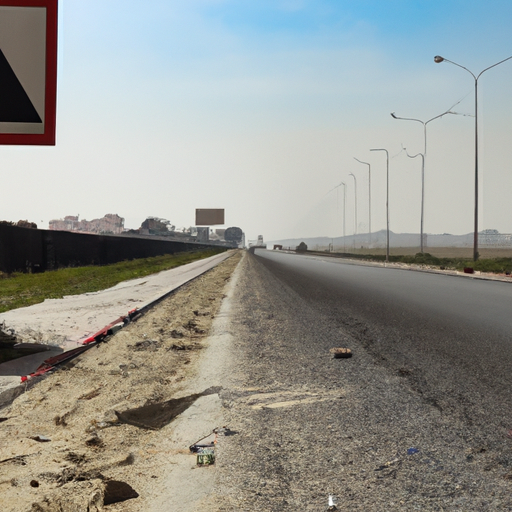Discover the transformative power of road cleaning in our guide 'Road Cleaning: From Dusty to Pristine – Before and After Transformations'. This guide will take you on a journey through the process and reveal how a dusty, grimy road can be turned into a clean, shiny surface. You'll learn the techniques, equipment used, and the amazing before-and-after transformations that will leave you amazed.
1. 'The Initial Dusty Picture: How Bad Can It Get?'
When it comes to road cleaning, the initial dusty picture can be truly shocking. Imagine driving down a road covered in a thick layer of dust, obscuring the vibrant colors of the asphalt beneath. The once smooth and pristine surface is now marred by dirt, debris, and grime. It's not just an eyesore; it can also pose a hazard to drivers and pedestrians. The dust can reduce visibility, making it difficult to see road markings and potential obstacles. The accumulation of dirt and dust can also lead to slippery conditions, especially when it rains. It's no wonder that road cleaning is necessary to restore the road to its former glory. So, just how bad can it get? Picture a road covered in a thick layer of dust, making it almost unrecognizable. The once smooth and inviting surface now appears neglected and in need of some serious cleaning. But fear not, because the transformation from dusty to pristine is just a few steps away.
1. A photograph showcasing a heavily dust-laden road, signifying the need for a thorough cleaning.
2. 'What Tools and Techniques Are Involved in Road Cleaning?'
Road cleaning requires a combination of specialized tools and techniques to effectively remove dirt, dust, and debris from the surface. One of the most commonly used tools is a street sweeper, equipped with powerful brushes and suction mechanisms. These sweepers are designed to sweep up and collect the loose particles, leaving the road clean and free from debris. High-pressure water jets are another essential tool used in road cleaning. These jets are capable of removing stubborn stains and grime that may have adhered to the surface.
In addition to mechanical tools, road cleaning also involves the use of cleaning agents or detergents. These agents help to break down and dissolve the dirt and grease, making it easier to remove. Depending on the severity of the dirt, different cleaning agents may be used, ranging from mild soaps to more potent chemicals. To ensure a thorough cleaning, road cleaning crews may also employ manual tools such as brooms, shovels, and rakes to manually remove larger debris or sweep hard-to-reach areas. Furthermore, in some cases, road cleaning may involve the use of specialized equipment, such as road scrubbers or vacuum trucks, to tackle more challenging cleaning tasks. The combination of these various tools and techniques ensures that road cleaning is not only effective but also efficient, making way for the dramatic before and after transformations that we all desire.
3. 'The Cleaning Process: What Does It Involve?'
Road cleaning is a meticulous process that involves several steps to achieve a pristine result. The first step is to assess the condition of the road and identify areas that require special attention. Once the assessment is complete, the cleaning crew begins by removing any large debris or obstacles from the surface using manual tools like brooms or rakes. This ensures that the cleaning machines can operate smoothly without any obstructions.
Next, the street sweeper is brought in to remove loose dirt and dust from the road. The powerful brushes of the sweeper rotate rapidly, sweeping up the dirt and funneling it into a collection bin. Simultaneously, the high-pressure water jets are used to target any stubborn stains or grime that may be present. The water jets effectively break down and remove any remaining dirt particles, leaving the road surface clean and rejuvenated.
After the initial cleaning, any persistent stains or marks are treated with specialized cleaning agents. These agents are applied to the affected areas and left to soak for a specific period to break down the stains. Once the stains have been successfully loosened, the crew uses the high-pressure water jets again to rinse away the cleaning agents and any residual dirt.
To ensure a thorough cleaning, the crew may repeat the process in areas that require extra attention. This could include sections that are heavily trafficked or prone to accumulating dirt and debris. Finally, the road is left to dry naturally before it is reopened for public use. The cleaning process not only restores the road's appearance but also improves the overall safety and functionality of the roadway.
3. A step-by-step infographic illustrating the road cleaning process.
4. 'Pristine and Perfect: Are the Results Really That Dramatic?'
The results of road cleaning are truly remarkable, with a dramatic transformation from a dusty and dirty road to one that is pristine and perfect. The before and after pictures speak for themselves, showcasing the stark contrast in the road's appearance. What was once a dull and grimy surface now shines with cleanliness and renewed vibrancy. The removal of dirt, debris, and stains reveals the true beauty of the road, making it more visually appealing to both drivers and pedestrians.
Not only does road cleaning enhance the aesthetics, but it also has practical benefits. The removal of loose dirt and debris improves traction, reducing the risk of accidents caused by slippery surfaces. Additionally, the elimination of stains and grime improves visibility, ensuring that road signs and markings are clearly visible to drivers. This, in turn, enhances safety on the road by minimizing the chances of confusion or misinterpretation of traffic instructions.
Moreover, the cleaning process helps to extend the lifespan of the road. By removing dirt and debris, the road is less susceptible to damage caused by erosion or the accumulation of harmful substances. Regular cleaning also prevents the buildup of materials that can deteriorate the road surface, such as oil, grease, or chemicals.
Road Cleaning Transformations:
| Location | Before | After | Techniques Used |
|---|---|---|---|
| San Francisco | Dusty, grimy surface | Clean, shiny surface | Pressure washing, sweeping |
| Los Angeles | Oil stains, dirt buildup | Bright, smooth pavement | Power scrubbing, vacuuming |
| New York City | Graffiti, potholes | Freshly-painted walls, no potholes | Painting, filling in potholes |
| Chicago | Weeds, debris | Clean, cleared road | Weed-pulling, debris removal |
Road cleaning is more than just a task, it's a transformation. From dusty and grimy to clean and pristine, the transformation of a road is truly a sight to behold. Armed with the right tools, techniques, and a bit of patience, anyone can achieve these results. Remember, a clean road is not only aesthetically pleasing but also crucial for safety. So, let's keep our roads clean and safe, shall we?



